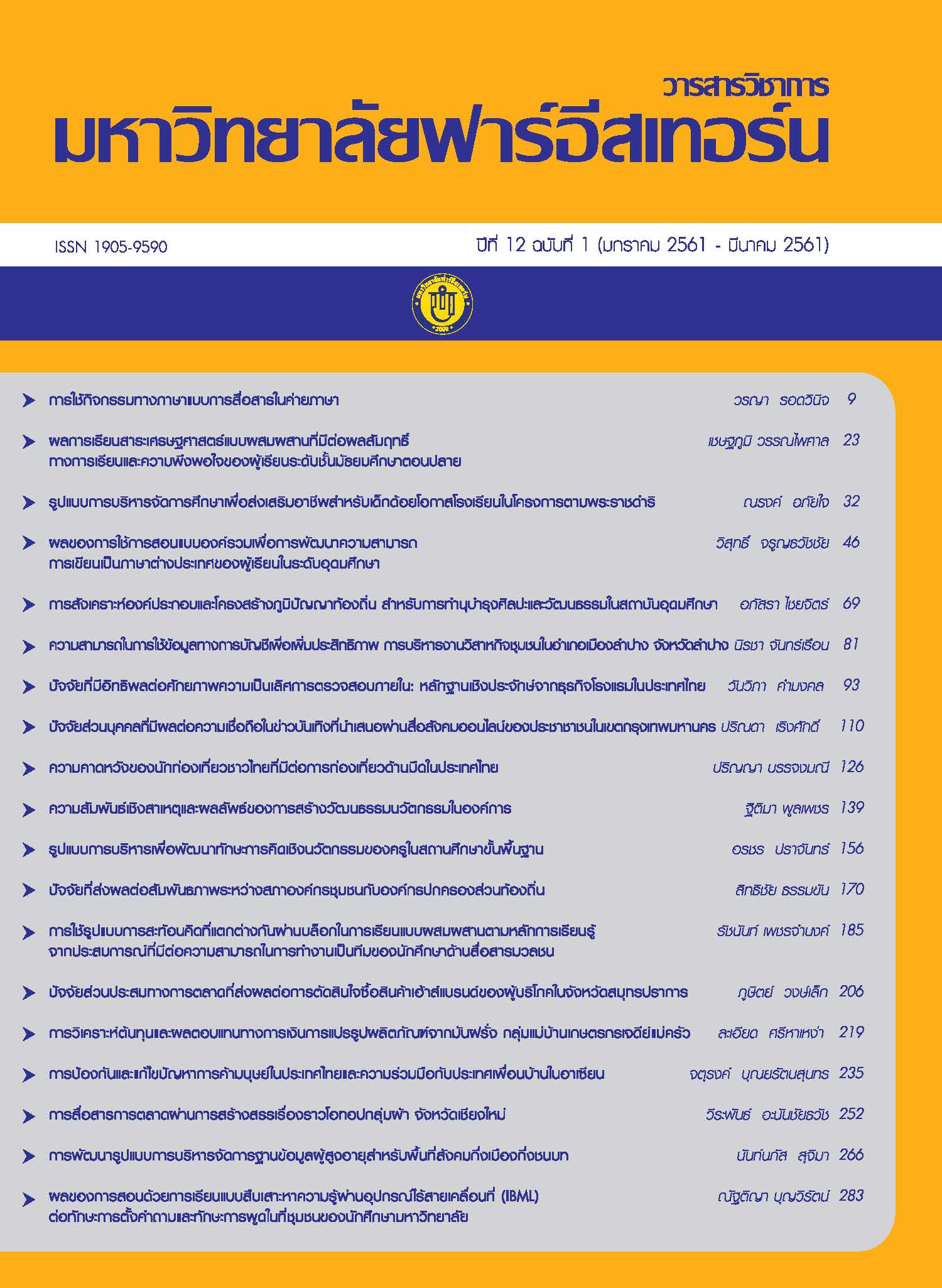การสื่อสารการตลาดผ่านการสร้างสรรเรื่องราวโอทอปกลุ่มผ้า จังหวัดเชียงใหม่
Main Article Content
Abstract
การวิจัยนี้มีวัตถุประสงค์เพื่อ 1) ศึกษาปัญหา และอุปสรรค และแนวทางการแก้ปัญหาของการสื่อสารการตลาดผ่านเรื่องราวผลิตภัณฑ์ OTOP กลุ่มผ้า จังหวัดเชียงใหม่ 2) พัฒนาแนวทางการสื่อสารเรื่องราวผลิตภัณฑ์ OTOP กลุ่มผ้า จังหวัดเชียงใหม่ 3) ศึกษาประโยชน์ของการพัฒนาการสื่อสารเรื่องราวผลิตภัณฑ์ OTOP กลุ่มผ้า จังหวัดเชียงใหม่ เป็นการวิจัยเชิงคุณภาพ โดยผู้วิจัยได้รวบรวมข้อมูลจากการสนทนากลุ่มกับผู้ให้ข้อมูลสำคัญ จำนวน 29 คน จำแนกเป็น ผู้ประกอบการ OTOP กลุ่มผ้าที่ได้ระดับ 5 ดาว 15 คน ได้ระดับน้อยกว่า 5 ดาว 8 คน และนักวิชาการ 6 คน วิเคราะห์ข้อมูลโดยการวิเคราะห์เนื้อหาผลการวิจัยพบว่า 1) ปัญหาการสื่อสารเรื่องราวสินค้าผ่านเครื่องมือการสื่อสารการตลาด ประกอบด้วยปัญหาเทคนิคการสื่อสารการตลาด วิธีแก้ปัญหาคือ ศึกษาเทคนิคการสื่อสารการตลาดเพิ่มเติมเพื่อให้เข้าถึงและเกิดการรับรู้ โดยใช้เครื่องมือการสื่อสารหลายรูปแบบ ปัญหาเทคนิคการสร้างภาพ และข้อความ วิธีแก้ปัญหาคือ อบรมความรู้ด้านการจัดทำเนื้อหาข้อความ และจัดทำตำราเกี่ยวกับการสร้างเนื้อหาโดยเฉพาะ ปัญหาด้านจริยธรรมเป็นการคัดลอกการเขียนเรื่องราว วิธีแก้ปัญหาคือ พัฒนาการเขียนอย่างต่อเนื่อง พัฒนาการสื่อสารให้ตรงใจลูกค้า สำหรับแนวทางการพัฒนาการสื่อสารเรื่องราวผลิตภัณฑ์ มุ่งเน้นการใช้เครื่องมือการประชาสัมพันธ์ ผ่านสื่อออนไลน์ได้แก่ Facebook และ Line โดยในอนาคตเน้นการทำโฆษณาผ่าน Facebook 2)ประโยชน์ที่ได้รับจากการสื่อสารเรื่องราวผลิตภัณฑ์ ด้านรูปธรรม คือ ยอดขาย ผลกำไร รายได้ จำนวนลูกค้าใหม่เพิ่มมากขึ้น ได้รับรางวัลจากการประกวด ได้รับการรับรองมาตรฐานสินค้า เป็นการขยายฐานการตลาด ส่วนประโยชน์จากการสื่อสารเรื่องราวผลิตภัณฑ์ ด้านนามธรรมคือ มีแรงบันดาลใจในการทำธุรกิจ เป็นการสร้างเอกลักษณ์สินค้า เกิดคุณค่า และความภักดีต่อตราสินค้า ตลอดจนมีความได้เปรียบทางการแข่งขัน
The purposes of this research were to find out: 1) investigate problems, obstacles and solutions to the story communication problems through story of The Chiang Mai OTOP Fabric Cluster; 2) find out the guidelines for their story communication development of The Chiang Mai OTOP Fabric Cluster; 3) indicate the benefits of story communication development on The Chiang Mai OTOP Fabric Cluster. This research conducted by qualitative research methodology, the data collected from a focus group with 29 key informants (15 OTOP 5-star entrepreneurs, 8 OTOP 1-4 star entrepreneurs and 6 academic scholars), data analysis conducted by content analysis technique. The research findings research were as follows: 1) The problems and obstacles of the cluster involved marketing communication techniques, the solutions were to train the entrepreneurs about marketing communication techniques and how to use different communication tools. For image and text creation problems, the solution was to provide the entrepreneurs with training and special textbooks. For text copying problems, the solution was to encourage the entrepreneurs to develop themselves constantly and develop communication process that is right for the customers. The guideline for story communication development should focus on the use of online media i.e. Facebook and Line that allow customers’ interaction and product image creation. In the future, the entrepreneurs should Facebook Ads. Function in order to increase their sale volume. 2) The entrepreneurs gained more advantage from the story telling of their products in tangible benefit such as sale volume, profits, more new customers and better income, award winning, standard accredited. There were also indirect benefits from the product’s story telling were the entrepreneurs had better business inspiration, the better image of product created brand loyalty and competitive advantage.
Article Details
1. Any views and comments in the Journal of Social Innovation and Lifelong Learning are the authors’ views. The editorial staff have not to agree with those views and it is not considered as the editorial’s responsibility.
2. The responsibility of content and draft check of each article belongs to each author. In case, there is any lawsuit about copyright infringement. It is considered as the authors’ sole responsibility.
3. The article copyright belonging to the authors and The Far Eastern University are copyrighted legally. Republication must be received direct permission from the authors and The Far Eastern University in written form.
References
บรินดา สัณหฉวี (2560). แนวทางการสร้างผลประกอบการที่ด้วยนวัตกรรมบริการของธุรกิจรีสอร์ท ในประเทศไทย. วารสาร มจร สังคมศาสตร์ ปริทรรศน์. 6(2), 65-74.
บุญธรรม กิจปรีดาบริสุทธิ์. (2551). เทคนิคการสร้างเครื่องมือรวบรวมข้อมูลสำหรับการวิจัย.(พิมพครั้งที่ 7). กรุงเทพฯ: ศรีอนันต์การพิมพ์. 58.
ระบบศูนย์ข้อมูลกลางเพื่อการบริหารจัดเก็บและใช้ประโยชน์. (2559). รวมผลการจำหน่ายสินค้าหนึ่งตำบล หนึ่งผลิตภัณฑ์ ประจำปีงบประมาณ 2559 ระหว่างเดือน ตุลาคม 2558 - กันยายน 2559 (12 เดือน). สืบค้นเมื่อวันที่ 9 เดือนมีนาคม พ.ศ.2560. จาก
https://logi.cdd.go.th/cddcenter/cdd_report/otop_r04.php?&year=2559&org_group=0.
สำนักส่งเสริมภูมิปัญญาท้องถิ่นและวิสาหกิจชุมชน. (2558). คู่มือสำหรับประชาชน: กระบวนการคัดสรรสุดยอดหนึ่งตำบล หนึ่งผลิตภัณฑ์ไทย. กรุงเทพฯ: กรมการพัฒนาชุมชน กระทรวงมหาดไทย.
เสรี วงษ์มณฑา. (2549). การตลาดคือการสร้างคุณค่า. สืบค้นเมื่อวันที่ 9 เดือนมีนาคม พ.ศ.2560. จาก https://www.manager.co.th/iBizChannel/ViewNews.aspx?NewsID=9490000114546.
Clow, K. E. (2004). Integrated advertising, promotion, and marketing communications. India: Pearson Education. 102-103.
Fill Chris. (2013). Marketing Communications: brands, Experiences and Applications. 6rd ed. Harlow: Pearson Education, Inc. 416-418.
Fombrun, C. J., & Van Riel, C. B. (2004). Fame & fortune: How successful companies build winning reputations. Upper Saddle, NJ: Prentice Hall. 368.
Freytag, G. (1896). Freytag's technique of the drama: an exposition of dramatic composition and art. [Electronic book]. Michigan: Scholarly Press. Retrieved March 19, 2017, From https://books.google.co.th/books?hl=th&lr=&id=y10_AQAAMAAJ&oi=fnd&pg=PR7&dq=Freytag%27s+technique+of+the+drama:+an+exposition+of+dramatic+composition+and+art.+Scholarly+&ots=t1egPwIPtW&sig=n691vPMov6YgBEi-X4zBDyPuv94&redir_esc=y#v=onepage&q=Freytag's%20technique%20of%20the%20drama%3A%20an%20exposition%20of%20dramatic%20composition%20and%20art.%20Scholarly&f=false
Kotler, P. and Keller, K.L. (2016). Marketing Management. New Jersey: Prentice-Hall. 512, 515, 538-539
Kumar P. (2002). The impact of performance, cost and competitive considerations on the relationship between satisfaction and repurchase intent in business markets. Journal of Service Research. 5(1). 55-68.
Kurokawa, K. (2010). Food education as a regional development policy for all-with implications from community development in Japan and Thailand. Australasian journal of regional studies, 16(1), 51.
Morgan, R.M. and Hunt, S.D. (1994), The commitment-trust theory of relationship marketing. Journal of Marketing, 58 (3), 20-38.
Natalie T.J. Tindall, Derina Holtzhausen, (2012) Toward an integrated model of communication: the case of South Africa. Journal of Communication Management, 16(4), 371-387
Pelsmacker, P. D., Geuens, M., & Bergh, J. van den (2004). Marketing communications–A European perspective. Pearson Education. 370
Shimp,T.A.(2013).Advertising, Promotion, and other aspects of Integrated Marketing Communications. Nelson Education. 231-234
Walker, V. S. (1996). Their highest potential: An African American school community in the segregated South. [Electronic book]. North Carolina: University of North Carolina Press. Retrieved March 12, 2017, From https://books.google.co.th/books?id=1PyhdX1jJxYC&printsec=frontcover&dq=Their+highest+potential:+An+African+American+school+community+in+the+segregated+South&hl=th&sa=X&ved=0ahUKEwj7tbK7hOPXAhUFto8KHTKeAHwQ6AEIJDAA#v=onepage&q=Their%20highest%20potential%3A%20An%20African%20American%20school%20community%20in%20the%20segregated%20South&f=false
Walter, A. and Ritter, T. (2003), “The influence of adaptations, trust, and commitment on value-creating functions of customer relationships”, Journal of Business & Industrial Marketing, 18(4/5), 353-365.

